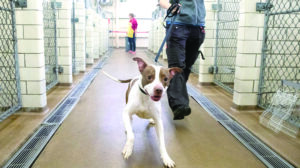By Dr. Beth Leermakers
My last column focused on evaluating whether this is the right time to adopt a dog. If you’ve decided to adopt a shelter dog, how do you proceed? When there are hundreds of dogs in a shelter — most clamoring for your attention — picking one can be daunting.

Photo courtesy of MPR Humane Society
Here are a few tips based on my experience fostering shelter dogs:
At the Shelter:
Ask a staff member or volunteer for recommendations. They can often steer you toward a wonderful dog that you may overlook because she doesn’t show well in her kennel. Volunteers often have more time to spend with the dogs outside their kennels, so look for those volunteer T-shirts or name tags. Keep an open mind. If you’re locked into a particular breed/color/sex, you may overlook dogs that would be a great match. If your apartment complex or homeowner’s association has breed or size restrictions (many do), choose accordingly.
Read the kennel card. If the dog was an owner surrender (or spent time in a shelter foster home), there may be notes about how the dog behaved in a home. Look for information about dog, cat- and kid-friendliness. Dallas Animal Services indicates play group style for the dog-social dogs: gentle and dainty (calm and laid back), rough and rowdy (love to tumble and wrestle), or push and pull (they enjoy chasing and driving others). Many shelter staff are unable to test dogs with cats and children, so a foster-to-adopt arrangement may be safer if you have young children and cats.
Meet dogs outside their kennels. Some dogs don’t show well in their kennels, and many dogs behave very differently away from the loud kennel. Spend time in the meet and greet room or play yard.
Bring your dog(s) for a meet and greet. The shelter staff or volunteers will help you introduce the dogs. Even if they get along well in the neutral area, it’s still wise to keep your new dog separate from your current dog(s) for at least three days.
Consider the shy/scared dogs. Many shy/scared dogs blossom as soon as they leave the shelter. Truly shy dogs (who are still shy at home) do best with patient people who have a relatively quiet home. If you have kids coming and going all the time, a shy dog probably isn’t your best choice.
Keep your new dog safe in the car. The shelter staff will provide a basic slip leash, but I recommend bringing a collar and leash so you can tether the dog in your car (especially if you’re by yourself and don’t want your 65-lb pup sharing the driver’s seat). I’ve had foster dogs knock my car out of gear while I’m on the highway — not the safest experience. If you brought your dog with you, keep them separate in the car by tethering them or crating them.
When you get home:
Close the garage door before you take your dog out of the car. A scared dog may bolt out of the car when you open the door. If you don’t park in the garage, be sure the slip leash is secure (around her neck, not her belly) before you open the door.
Give the dog a few days to decompress. Shelter life is often very stressful for dogs. They need time to sleep, relax and settle in. If you have other dogs/cats, keep your new pooch separate from the others for at least the first three days (preferably longer). I keep new foster dogs separated from my other dogs for at least the first 5-7 days. I put the foster dog in a crate in a spare bedroom and take her out every several hours (by herself) for exercise, potty breaks and snuggle time. Dogs need to smell each other (via urine in the yard), then see each other without touch, and then finally touch each other.
Crate train your pup. I used to think crates were terrible things, until I had a foster dog who’d lived on the streets for months and was very difficult to house train. Crate training works, and many dogs feel comfortable and safe in their crates. Dogs keep an eye on their environment, scanning for predators or other threats (e.g., the mailman or Amazon driver). When a dog is in a crate, his world is much smaller, so he doesn’t have to work as hard to monitor his surroundings. He can relax. My dogs often curl up in their crates with the door open.
Make the crate comfortable and pleasant. If your puppy chews bedding, you can use a comforter, blanket or towels instead of a dog bed. I use memory foam bath mats until I know the dog can be trusted not to destroy a dog bed. Give your pup a chew toy and/or Kong stuffed with treats and/or coated with peanut butter (you can freeze the Kong to make it last longer). Don’t forget water if your dog will spend more than an hour or two in his crate.
Give your new dog time to settle in. The “3-3-3 Rule” describes how long it takes many rescued dogs to adjust to their new life. Shy/scared dogs may take longer. Your new pup may feel overwhelmed (and not eat or drink) during the first three days. After three weeks, dogs start to settle into their new routine. After three months, many dogs feel comfortable in their new home. Visit rescuedogs101.com/bringing-new-dog-home-3-3-3-rule/ for more information.
If you need help with behavioral issues, consult a dog behaviorist who uses positive reinforcement (not punishment).
Thank you for adopting and saving a life!
